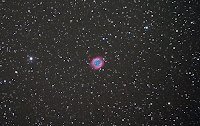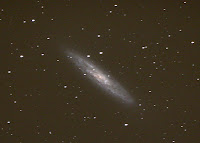
I've been taking pictures of the sky for decades now, and I end up learning something new every time I'm under a dark sky. Mostly one learns by making mistakes - taking what you thought was a 30 minute exposure, but the shutter was set to 1/500 second, leaving on the lens cap, standard stuff like that. It is easier now with the instant feedback of the digital cameras, but you can still have issues with weather, telescopes and equipment. Case in point was from one of my last times out - in the middle of a sequence on the Helix Nebula (a large, bright planetary nebula in Aquarius), my CamTrack unexpectedly stopped in mid-exposure for a minute, then restarted. While the left image here shows a stacked set of 12 exposures, the right one shows the trailed one. But even it has an unexpected appearance. The tracked image sections were nearly identical - reminding me of a pair of eyeballs, not unlike a current ad campaign for Geico Insurance!


Another example is a shot of the local group galaxy NGC 253, a mere 12 million light years away. It is a fine, bright galaxy, easily visible in binoculars, though low in the sky and tough to spot from the Midwest. In an effort to image it my last observing session, after spending a couple hours to setup the 14" Celestron and mount, install the Hyperstar optics, align and focus, I realized it was just too windy to get good exposures, even at 90 seconds of exposure. The blustery wind gusts, just made it impossible to keep the guide star on the cross hairs, so I gave up the idea of using the moderately long focal length of the C14 + Hyperstar that night. And while it looks ok as a thumbnail, looking at even a moderate scale shows icky images...

So what do you shoot on a perfectly clear but windy night? Well, the CamTrack looked stable enough, so I mounted up a wide-angle lens and shot a half dozen frames of the
Gegenshein. I file this object under the "frequently observed but rarely noticed" category. It is up most every night, but you really have to look for it from a dark site to see it, but really is visible most every night. It is the reflection of sunlight from interplanetary dust in the solar system and always appears opposite the sun, so is at it's highest at midnight. In this exposure, 18 minutes of exposure with the 10-22mm zoom set to the widest view shows the sky from Jupiter to Taurus and also shows the Andromeda and Triangulum galaxies and a host of other fainter sky objects. The diffuse elongated glow along the line from Jupiter to the Pleiades is part of the zodiacal band and Gegenshein. Even observing buddy Christian, an advanced European observer had never noticed/seen it before, so I was able to provide a first for him...
 I've been taking pictures of the sky for decades now, and I end up learning something new every time I'm under a dark sky. Mostly one learns by making mistakes - taking what you thought was a 30 minute exposure, but the shutter was set to 1/500 second, leaving on the lens cap, standard stuff like that. It is easier now with the instant feedback of the digital cameras, but you can still have issues with weather, telescopes and equipment. Case in point was from one of my last times out - in the middle of a sequence on the Helix Nebula (a large, bright planetary nebula in Aquarius), my CamTrack unexpectedly stopped in mid-exposure for a minute, then restarted. While the left image here shows a stacked set of 12 exposures, the right one shows the trailed one. But even it has an unexpected appearance. The tracked image sections were nearly identical - reminding me of a pair of eyeballs, not unlike a current ad campaign for Geico Insurance!
I've been taking pictures of the sky for decades now, and I end up learning something new every time I'm under a dark sky. Mostly one learns by making mistakes - taking what you thought was a 30 minute exposure, but the shutter was set to 1/500 second, leaving on the lens cap, standard stuff like that. It is easier now with the instant feedback of the digital cameras, but you can still have issues with weather, telescopes and equipment. Case in point was from one of my last times out - in the middle of a sequence on the Helix Nebula (a large, bright planetary nebula in Aquarius), my CamTrack unexpectedly stopped in mid-exposure for a minute, then restarted. While the left image here shows a stacked set of 12 exposures, the right one shows the trailed one. But even it has an unexpected appearance. The tracked image sections were nearly identical - reminding me of a pair of eyeballs, not unlike a current ad campaign for Geico Insurance! Another example is a shot of the local group galaxy NGC 253, a mere 12 million light years away. It is a fine, bright galaxy, easily visible in binoculars, though low in the sky and tough to spot from the Midwest. In an effort to image it my last observing session, after spending a couple hours to setup the 14" Celestron and mount, install the Hyperstar optics, align and focus, I realized it was just too windy to get good exposures, even at 90 seconds of exposure. The blustery wind gusts, just made it impossible to keep the guide star on the cross hairs, so I gave up the idea of using the moderately long focal length of the C14 + Hyperstar that night. And while it looks ok as a thumbnail, looking at even a moderate scale shows icky images...
Another example is a shot of the local group galaxy NGC 253, a mere 12 million light years away. It is a fine, bright galaxy, easily visible in binoculars, though low in the sky and tough to spot from the Midwest. In an effort to image it my last observing session, after spending a couple hours to setup the 14" Celestron and mount, install the Hyperstar optics, align and focus, I realized it was just too windy to get good exposures, even at 90 seconds of exposure. The blustery wind gusts, just made it impossible to keep the guide star on the cross hairs, so I gave up the idea of using the moderately long focal length of the C14 + Hyperstar that night. And while it looks ok as a thumbnail, looking at even a moderate scale shows icky images... So what do you shoot on a perfectly clear but windy night? Well, the CamTrack looked stable enough, so I mounted up a wide-angle lens and shot a half dozen frames of the Gegenshein. I file this object under the "frequently observed but rarely noticed" category. It is up most every night, but you really have to look for it from a dark site to see it, but really is visible most every night. It is the reflection of sunlight from interplanetary dust in the solar system and always appears opposite the sun, so is at it's highest at midnight. In this exposure, 18 minutes of exposure with the 10-22mm zoom set to the widest view shows the sky from Jupiter to Taurus and also shows the Andromeda and Triangulum galaxies and a host of other fainter sky objects. The diffuse elongated glow along the line from Jupiter to the Pleiades is part of the zodiacal band and Gegenshein. Even observing buddy Christian, an advanced European observer had never noticed/seen it before, so I was able to provide a first for him...
So what do you shoot on a perfectly clear but windy night? Well, the CamTrack looked stable enough, so I mounted up a wide-angle lens and shot a half dozen frames of the Gegenshein. I file this object under the "frequently observed but rarely noticed" category. It is up most every night, but you really have to look for it from a dark site to see it, but really is visible most every night. It is the reflection of sunlight from interplanetary dust in the solar system and always appears opposite the sun, so is at it's highest at midnight. In this exposure, 18 minutes of exposure with the 10-22mm zoom set to the widest view shows the sky from Jupiter to Taurus and also shows the Andromeda and Triangulum galaxies and a host of other fainter sky objects. The diffuse elongated glow along the line from Jupiter to the Pleiades is part of the zodiacal band and Gegenshein. Even observing buddy Christian, an advanced European observer had never noticed/seen it before, so I was able to provide a first for him...















1 comment:
...and a first for me as well. Many thanks for sharing that with us.
Post a Comment